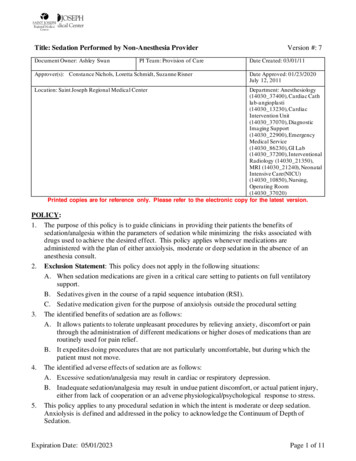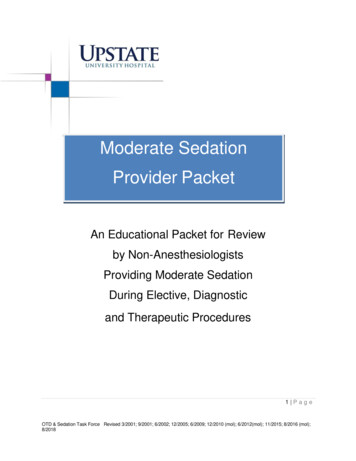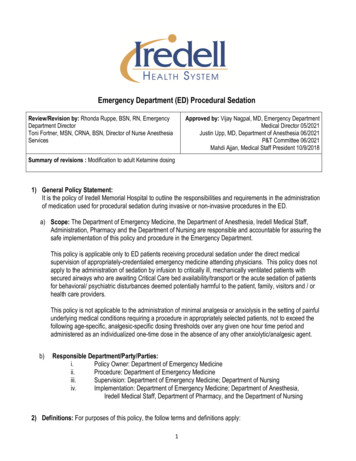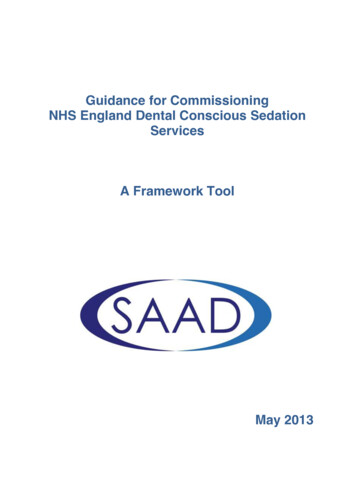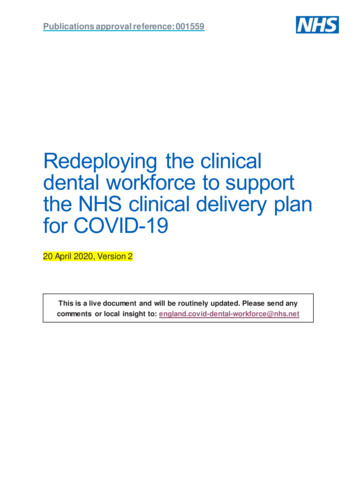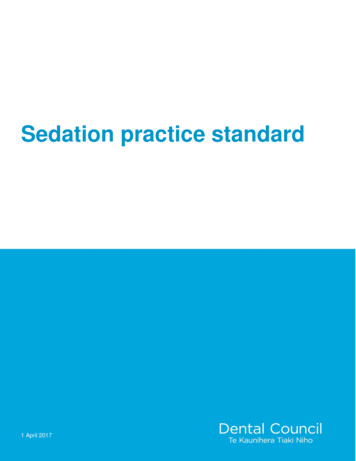
Transcription
Sedation practice standard1 April 2017
ForewordStandards frameworkThe Dental Council (the “Council”) is legally required to set standards of clinical competence, culturalcompetence and ethical conduct to be observed by all registered oral health practitioners(“practitioners”)a. This means that compliance to the Council’s standards by practitioners ismandatory.The Council has established a standards framework which defines the ethical principles, professionalstandards and practice standards that all practitioners must meet.There are five ethical principles that practitioners must adhere to at all times.Practitioners must: put patients’ interests first ensure safe practice communicate effectively provide good care maintain public trust and confidence.Each of the five ethical principles is supported by a number of professional standards which articulatewhat a practitioner must do to ensure they achieve the ethical principles. The professional standardsare, in turn, supported by practice standards which relate to specific areas of practice that requiremore detailed standards to enable practitioners to meet the professional standards and ethicalprinciples.A copy of the standards framework is available on the Dental Council’s website.ComplianceThe standards set by the Council are minimum standards which are used by the Council, the public ofNew Zealand, competence review committees, professional conduct committees, the Health andDisability Commissioner, the Health Practitioners Disciplinary Tribunal and the courts, to measure thecompetence, performance and conduct of practitioners.A failure to meet the Council’s standards and adhere to the ethical principles could result in DentalCouncil involvement and may impact on the practitioner’s practice.Sometimes factors outside of a practitioner’s control may affect whether or not, or how, they can meetthe standards. In such circumstances, practitioners are expected to adhere to the ethical principles,demonstrate insight and use their professional judgement to determine appropriate behaviour.Practitioners must be able to justify their behaviour when this is contrary to the standards, anddocument their reasons.aOral health practitioners include dentists, dental specialists, dental hygienists, dental therapists, oral health therapists, clinical dental technicians,dental technicians, and orthodontic auxiliaries.aOral health practitioners include dentists, dental specialists, dental hygienists, dental therapists, clinical dental technicians, dental technicians, andorthodontic auxiliaries.2
ContentsIntroduction4Sedation practice standard9Part 1: Preparation for sedation10Patient assessment10Informed consent11Pre-operative instructions11Part II: Providing sedation13Sedation techniques and drugs13Environment for sedation14Clinical team for sedation16Monitoring18Use of oxygen19Recovery and discharge20Sedation-related complications21Part III: Education and training22Part IV: Documentation23Sedation records23Appendix A: American Society of Anesthesiologists’ (ASA) Classification of Physical Status26Appendix B: Core competencies to provide sedation27Appendix C: Core competencies to monitor-only sedated patients293
IntroductionThis introduction provides commentary on the Sedation practice standard and context for the standards within it, and doesnot form part of the practice standard.The Sedation practice standard contains: The Dental Council standards (the ‘standards’) for sedation that all registered oral health practitioners(‘practitioners’) who practise as part of the clinical team for sedation must meet. These are presented in thenumbered coloured boxes -#The standards that practitioners must meet.and Guidance which describes the actions and behaviour that enable practitioners to meet the minimum standards. If apractitioner does not follow the guidance, they must be able to demonstrate to the Dental Council (the “Council”)that they meet the standards.This is presented in the grey-shaded boxes directly following the relevant standard -Guidance The actions and behaviour that enable practitioners to meet the minimum standards.The practice standard is presented in four parts:I:Preparation for sedationII:Providing sedationIII:Education and trainingIV: Documentation.Duty of patient careThe Health and Disability Commissioner Code of Rights provides that every consumer has the right to have servicesprovided with reasonable care and skill1 that comply with legal, professional, ethical, and other relevant standards 2.In accordance with the ethical principles of the standards framework, practitioners have a responsibility to put their patients’interests first, and to protect those interests by practising safely and providing good care.Sedation is offered to dental patients with the aim of reducing anxiety and/or improving tolerance of dental treatment. Safepractice is of heightened importance in this practice area as the risks associated with sedation are significant.1Right 4(1) Health and Disability Commissioner Code of Health and Disability Services Consumers’ Rights Regulations 1996.2Right 4(2) Health and Disability Commissioner Code of Health and Disability Services Consumers’ Rights Regulations 1996.4
Practitioners who practise as part of the clinical team for sedation must ensure they are appropriately educated and skilledin this practice area, and that patient safety is their primary consideration.PurposeThe purpose of the Sedation practice standard is to set minimum standards for the practice of minimal and moderatesedation3 in dentistry.It applies when a practitioner administers a drug or drugs to relieve patient anxiety and/or to provide sedation, and when apractitioner recommends or prescribes a sedative drug that the patient self-administers.It also applies when a practitioner proceeds with treatment knowing at the time of appointment, that the patient has selfadministered a sedative drug or drugs that the practitioner has not prescribed or recommended. If treatment cannotproceed, assist the patient in making suitable arrangements for their safe transport home.It does not regulate techniques that are intended to induce deep sedation or loss of consciousness (general anaesthesia),where a specialist anaesthetist is required to administer the sedation or general anaesthesia and continuously monitor thepatient until recovery.Duty of compliancePractitioners who practise as part of the clinical team for sedation have a legal responsibility to meet the standardscontained in this practice standard.They must ensure that: their own clinical practices for sedation meet the standards; and the practice4 environment is suitable for sedation and meets the standards.There are various actions the Council can take in the event of a practitioner’s non-compliance with the standards. Theaction taken would depend on the individual circumstances of non-compliance.Sometimes factors outside of a practitioner’s control may affect whether or not, or how, they can meet the standards. Insuch circumstances, practitioners are expected to adhere to the ethical principles of the standards framework,demonstrate insight and use their professional judgement to determine appropriate behaviour.Practitioners must be able to justify their behaviour when this is contrary to the standards, and document their reasons.The Council’s Medical emergencies in dental practice - practice standard must be read in conjunction with the Sedationpractice standard.3The terms minimal sedation and moderate sedation are defined on page 6.4The “practice” is defined as all settings in which registered oral health practitioners perform activities associated with their scope of practice.5
Definitions5 Minimal sedation is a drug-induced state during which the patient responds normally to verbal commands.Cognitive function and physical co-ordination may be impaired but airway reflexes, cardiovascular and ventilatoryfunctions are unaffected. Moderate sedation is a drug-induced depression of consciousness during which patients respond purposefully6to verbal commands, either alone or accompanied by light tactile stimulation, throughout the period of sedation.The patient has the ability to maintain their airway patency on request, spontaneous ventilation is adequate andcardiovascular function is usually maintained. Deep sedation is a drug-induced depression of consciousness during which patients cannot easily be woken butrespond purposefully following repeated or painful stimulation. The ability to independently maintain ventilatoryfunction may be impaired. Patients may require assistance in maintaining a patent airway, and spontaneousventilation may be inadequate. Cardiovascular function is usually maintained. General anaesthesia is a drug-induced loss of consciousness during which patients are not able to be woken,even by painful stimulation. The ability to independently maintain ventilatory function is often impaired. Patientsoften require assistance in maintaining a patent airway, and positive pressure ventilation may be requiredbecause of depressed spontaneous ventilation or drug-induced depression of neuromuscular function.Cardiovascular function may be impaired. Sedation-related complications are complications resulting from sedation and include, but are not limited to:oDepression of consciousness beyond the intended level of sedationoAirway nciples of safe sedationThe transition from complete consciousness through the various levels of sedation to general anaesthesia is a continuum,and not a set of discrete, well-defined stages. It is accompanied by increasing depression of the central nervous systemand other physiological systems, which if not effectively monitored and managed may progress to poor outcomes.The response of an individual patient to sedatives is not always predictable and, at times, it can be difficult to define theend-point of the target state.Therefore, for safe and effective sedation practice it is absolutely essential: That practitioners complete formal education and training7 to gain the necessary knowledge and skills to safelyand competently provide sedation; and maintain competence. That practitioners use only those techniques and drugs for sedation in which they are formally educated andtrained.5Adapted from the American Society of Anesthesiologists Continuum of Depth of Sedation: Definition of general anesthesia and levels of sedation/analgesia; with the exception of sedation-related complications6Reflex withdrawal from a painful stimulus is NOT considered a purposeful response7Refer to Part III of the practice standard6
That the drugs used for minimal and moderate sedation have a margin of safety that is wide enough to makedeep sedation or general anaesthesia unlikely. That practitioners providing sedation are able to identify sedation–related complications and appropriatelymanage the patient.Sedation techniques and drugsSedation may be achieved by a wide variety of drugs and techniques, and may accompany techniques for painmanagement such as local anaesthetic. In dental practice the most common sedation techniques are inhalation usingnitrous oxide/oxygen, oral, and intravenous (IV).A particular technique may be used with one or more drugs to achieve a range of sedative effects within the continuum.No one technique, drug, or combination of drugs, is suitable for all patients; and individual patients may need differentsedation techniques and drugs at different times.Each technique, and an understanding of the pharmacokinetics and pharmacodynamics of the drug(s) used with it,requires formal education and training for safe practice.The ease of administration of a sedative does not necessarily reflect the degree of safety associated with it.Techniques that do not allow the drug to be titrated to effect, for example, the oral administration of sedative drugs, canresult in a less predictable response than when a drug is administered intravenously or via inhalation.For this reason, oral sedation should only be used for an intended level of minimal sedation.AcknowledgementsThe Sedation practice standard is founded on a number of different sources, including the New Zealand DentalAssociation’s Code of Practice8, the Australian Dental Association’s recommended guidelines9, the Australian and NewZealand College of Anaesthetists guidelines10, and other international guidelines and standards. It has been developedwith advice from consultants that included oral health practitioners practising sedation at minimal and moderate levels,and an anaesthetist; and on the advice of staff members from the Faculty of Dentistry, University of Otago and theparticipants at the Council’s education discussion forum.8NZDA Code of Practice Sedation for dental procedures 20159ADA Policy Statement 6.17 Sedation in dentistry 201410ANZCA Guidelines on sedation and/or analgesia for diagnostic and interventional medical, dental or surgical procedures 20147
This page is intentionally left blank.8
Sedation practicestandard
Part I: Preparation for sedationPatient assessment1You must determine whether you can provide safe sedation for patients that is the most suitable for them,and refer appropriately if you cannot.Guidance Perform a thorough patient assessment, at a separate appointment before the planned sedation appointmentwhen possible, and record your findings. Include in the assessment: A complete medical history that records past medical history, history of previous sedation, current medicalconditions, current medications (prescribed and non-prescribed) and allergies. A physical examination that includes evaluation of the airway to determine if there is an increased risk ofairway obstruction, assessment of whether venous access is achievable, and other investigations asnecessary (e.g. measurement of blood pressure, weight). Refer to the American Society of Anesthesiologists’ (ASA) Physical Status Classification System (Appendix A),and record the ASA status of the patient. Normally only ASA I or ASA II patients are considered suitable for sedation as outpatients, depending on theeducation, training and experience of the practitioner providing the sedation and the appropriateness of theclinical environment. Consult with the patient’s general medical or specialist practitioner before any planned sedation if the patient hasa serious medical condition, is medically unstable, and/or results from the physical examination are of concern. If the patient is seriously medically compromised and/or the results of the physical examination indicate ananaesthetist is required, an anaesthetist must administer the sedation and monitor the patient; referral may benecessary. Consider the age of the patient when determining the safety and suitability of the care you can provide. Childrenpresent increased challenges from an airway and venous access point of view, and extremes of age may affectthe sensitivity of the patient to the sedative(s). When your abilities and experience in sedation are not appropriate for the age of the patient, referral is the safestand most suitable option for care. Explore all relevant anxiety and pain management techniques with the patient, to ensure all possible options areconsidered and the most suitable is identified to enable treatment to be carried out for them. Behaviouralmanagement, local analgesia or general anaesthesia may be suitable alternative options to sedation. Update the medical history at the sedation appointment.10
Informed consentYou must provide patients with the information they need or request, in a way they can understand, toenable their informed consent for sedation and the planned dental treatment, before being sedated.2Guidance Fully explain the risks and benefits of the method of sedation proposed as the most suitable in the patient’scircumstance. Fully explain the planned dental treatment. Before sedation, inform the patient of any possible changes to the planned dental treatment during the period ofsedation, and gain informed consent for these potential changes. Patients who are already sedated cannot beconsidered able to make valid decisions and give informed consent. Confirm the patient’s understanding of the information given, and provide them with an opportunity for discussion. Obtain the patient’s informed consent for sedation and the planned dental treatment, in writing.Pre-operative instructionsYou must provide patients with comprehensive and understandable pre-operative instructions, both verbaland written, before the sedation appointment.3Guidance 11Include information on the following in the verbal and written pre-operative instructions, appropriate for thesedation technique and drug(s) used, and relevant for the patient’s needs: Pre-sedation fasting protocol Recovery:oWhat the patient might expect during recovery from the sedationoThe need for the patient to arrange an escort11- a responsible adult to accompany the patient home andcare for the patient for the time specified by the practitioner who administered the sedationoAdvice on the need to avoid activities that might place the patient at risk of injury or disadvantageoAfter-hours contact details for emergency advice and servicesAn escort is not normally required for adult patients who have received nitrous oxide sedation.11
oCare advice e.g. pain-relief medication. Allow the patient time to read the pre-operative instructions, preferably at the assessment appointment, confirmtheir understanding of the information, and provide them with the opportunity to ask any questions. Confirm the patient’s compliance with the pre-operative instructions, and that a suitable escort and transportationhave been arranged, before starting sedation.12
Part II: Providing sedationSedation techniques and drugs4You must use only sedation techniques in which you have been formally trained and are competent.5You must administer only drugs for which you have gained an understanding of their pharmacokineticsand pharmacodynamics through formal education.Note: Formal education and training is defined in Part III of this practice standard.6You must use drugs in a manner that is unlikely to cause loss of consciousness, and/or impair ventilatoryor cardiovascular function.Guidance Know the physiological effects of the drugs you use, and be aware of potential adverse effects and druginteractions with prescribed and non-prescribed medications, which may influence the impact of the sedativedrug(s). Know the time of onset, time to peak effect, and duration of action for each drug you use; related to theadministration technique used. Preferably use techniques that allow drugs to be titrated to effect, to minimise the risk of sedating the patient to adeeper level than intended. Be aware of the potential synergistic effects of sedative drugs when used in combination, and do not use morethan one sedative drug when sedating a patient unless you are trained and competent in using that particularcombination of drugs. Understand the relevance of a drug’s therapeutic index on the margin of safety that exists for its use.13
Environment for sedation7You must ensure that the treatment and recovery areas are appropriately sized, configured and equippedfor the sedation technique being used, to facilitate safe sedation and recovery - including managementof sedation-related complications.GuidanceTreatment and recovery areas Have treatment and recovery areas that are large enough to accommodate the clinical team and equipmentrequired for providing sedation, monitoring and emergency management. Have the following in the treatment and recovery areas when providing sedation by any technique: An operating table, trolley or chair which can be readily tilted into a horizontal or head-down position Adequate floor space for ease of movement Adequate suction and room lighting, and an alternative means of supplying both in the event of a powerfailure An oxygen supply and associated equipment suitable for delivering high flow oxygen Emergency drugs and equipment as specified in the Council’s Medical emergencies in dental practice –practice standard.14
Have the following equipment in the treatment and recovery areas, except when using only nitrous oxide/oxygenfor sedation: A pulse oximeter An automated device for measuring blood pressure. The patient’s recovery can occur either in the treatment area or in a dedicated recovery area. Maintain adequate access throughout the facility to allow the patient to be moved easily and safely from thetreatment area to the recovery area, if these are in different locations; and adequate access for emergencyservices.Equipment and services for nitrous oxide/oxygen sedation12 Use equipment for nitrous oxide/oxygen sedation that meets the following specifications: A minimum oxygen flow of 2.5 litres/minute with a maximum flow of 10 litres/minute of nitrous oxide, or inmachines so calibrated, a minimum of 30% oxygen Capacity for administration of 100% oxygen An anti-hypoxic device which cuts off nitrous oxide flow in the event of an oxygen supply failure, and opensthe system to allow the patient to breathe room air A non-return valve to prevent re-breathing, and a reservoir bag A patient breathing circuit of lightweight construction and low resistance to normal gas flows A low gas-flow alarm An appropriate method for scavenging of expired gases. Have a reserve supply of oxygen readily available, with associated equipment for its use. Service nitrous oxide/oxygen equipment according to manufacturer’s recommendations, at least annually. Install, maintain and service any piped gas system according to appropriate standards, at least annually. Check the equipment and the associated system for gas delivery is working properly before administeringsedation. Consider risks of chronic exposure to nitrous oxide.12Adapted from ADA Policy statement ‘Sedation in Dentistry’ and ANZCA guidelines on sedation and/or analgesia for diagnostic and interventionalmedical, dental or surgical procedures.15
Clinical team for sedation8You must meet the specified requirements for sedation team members, as applicable to the intendedlevel of sedation, defined in the tables below.For an intended level of minimal sedation:The following scenarios are acceptable:Scenario 1Scenario 213Team Member 1Team Member 2The ‘operator-sedationist’:The ‘1st assistant’:–administers the sedation and performsthe dental treatment–primarily monitors the patient throughoutthe dental treatment, and may assist inthe dental treatment–must be a dentist or dental specialistwho is appropriately educated andtrained, in sedation.13–must, at minimum, have receivededucation and training in monitoring ofsedated patients13–may be a non-registered team member,for example, a chairside assistant.The ‘sedationist’:The ‘operator’:–administers the sedation and monitorsthe patient throughout the dentaltreatment––must be a dental or medicalpractitioner who is appropriatelyeducated and trained, in sedation.13Refer to Part III of the practice standard16the oral health practitioner who performsthe dental treatment.
For an intended level of moderate sedation:A three member team is required. A minimum of two team members must be present in the treatment areathroughout the sedation period in which the dental treatment is performed. A third team member must be immediatelyavailable to assist, when required.The following scenarios are acceptable:Scenario 1Scenario 2Team member 1Team member 2Team member 3 (whenrequired)The ‘operator-sedationist’:The ‘1st assistant’:The ‘2nd assistant’:–administers the sedationand performs the dentaltreatment–primarily monitors the patientthroughout the dentaltreatment, and may assist inthe dental treatment––must be a dentist or dentalspecialist appropriatelyeducated and trained, insedation.14–must, at minimum, havereceived education andtraining in monitoring ofsedated patients.14assists the other teammembers.The ‘sedationist’:The ‘operator’:The ‘2nd assistant’:–administers the sedationand monitors the patientthroughout the dentaltreatment–––must be a dental or medicalpractitioner appropriatelyeducated and trained, insedation.14the oral health practitionerwho performs the dentaltreatment.assists the other teammembers.The ‘1st assistant’ and ‘2nd assistant’ may be non-registered team members, for example, a chairside assistant.14Refer to Part III of the practice standard17
Monitoring9You must monitor the patient, appropriately for the technique, drugs and level of sedation, throughoutthe sedation and recovery periods.Guidance Monitoring of the patient is to be performed by a member of the sedation team who has received formaleducation and training in monitoring the sedated patient15. Monitor the patient in the same way during the sedation and recovery periods.For all techniques and drugs administered for an intended level of minimal and moderate sedation,including nitrous oxide/oxygen: Observe the patient’s level of consciousness, and rate and depth of breathing, directly and continuously. Communicate regularly with the patient during the period of sedation and recovery to confirm the patient’s abilityto respond to verbal commands - as an indicator of a state of minimal or moderate sedation.For all techniques and drugs administered for an intended level of minimal and moderate sedation,excluding nitrous oxide/oxygen: Measure the blood pressure and heart rate by automated means, at the appropriate intervals. Continuously measure oxygen saturation of the blood using a pulse oximeter which alarms when certain setlimits are exceeded.1015You must use capnography to monitor the patient when providing an intended level of moderatesedation, except when using only nitrous oxide/oxygen for sedation [from 1 October 2019].Refer to Part III of the practice standard18
Use of oxygen11You must use oxygen appropriately for patients during the sedation and recovery periods.Guidance Have the knowledge and skills to appropriately deliver oxygen to sedated patients. Consider the routine use of supplemental oxygen for patients from the commencement of sedation, through toreadiness for discharge, particularly for: patients with relevant medical conditions when multiple drug techniques are used when moderate sedation is intended. Have a positive-pressure oxygen delivery system immediately available for use, for the purposes ofsupplemental oxygen and correction of hypoxaemia, during the periods of sedation and recovery; and a backup supply of oxygen immediately available. Check the oxygen delivery system is fully functional before the start of the sedation procedure.19
Recovery and dischargeYou must, if you are the practitioner who performs the dental treatment, ensure:12 the person monitoring the patient throughout the recovery period has, at minimum, NZRC COREImmediate rescuer training or equivalent a practitioner with formal education and training in providing sedation remains on the premisesthroughout the recovery period the practitioner who sedated the patient assesses the patient’s suitability for discharge.Guidance Sedated patients are vulnerable; respect and protect the patient’s personal boundaries at all times. Use the following criteria, at minimum, to determine the suitability of the patient for discharge: The patient can recognise time, place and person Blood pressure and heart rate are within normal limits for that patient Respiratory status is not compromised The patient is able to walk with minimal assistance, or independently. Discharge the patient into the care of a suitable escort – usually a responsible adult to accompany the patienthome and care for the patient for the time specified by the practitioner who administered the sedation. Provide the patient and escort with verbal and written instructions for the care and safety of the sedated patient,including emergency contact(s) information. Confirm the escort’s understanding of the patient care instructions, and their agreement and capability to carefor the patient as described. The patient’s safety is the primary objective. In the event the escort does not arrive, make alternativearrangements to ensure the safety of the patient in the post sedation period.20
Sedation-related complications13You must be able to identify and manage sedation-related complications, fitting for your role in thesedation team.Guidance Identify sedation-related complications by correct monitoring of the patient. Assure yourself that other members of the sedation team involved in monitoring the patient can identify sedationrelated complications. When you are the ‘sedationist’ or ‘operator-sedationist’ and sedation-related complications are identified: Stop dental treatment and direct all members of the sedation team to devote their entire attention to themedical care of the patient. Continue monitoring the patient, and appropriately manage the situation until either the patient returnssafely to the intended level of sedation, or emergency services arrive. IV administration of a suitablereversal drug/s may be appropriate. Be prepared to use resuscitation techniques, if required. Contact emergency medical services for assistance as soon as you feel unable to manage the situation,and/or the patient is unresponsive to early management strategies.14You must have written procedures for managing sedation-related complications where the role of eachsedation team member is clearly defined, and ensure these are known by all team members andrehearsed frequently.Guidance Include emergency evacuation procedures as part of the sedation-related management protocols. Confirm each team member’s understanding of their role in the event of sedation-related complications. Rehearse the procedures as a team, at minimum, at six-monthly intervals.21
Part III
management such as local anaesthetic. In dental practice the most common sedation techniques are inhalation using . with advice from consultants that included oral health practitioners practising sedation at minimal and moderate levels, . participants at the Council's education discussion forum. 8 NZDA Code of Practice Sedation for dental .

